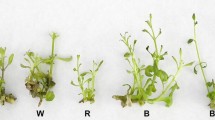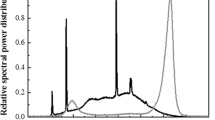Abstract
This study aimed at establishing a protocol to increase the number of regenerated shoots and to limit the recovery of “escapes” during the regeneration of transgenic flax plants (cv Barbara). Here, we describe how light, adapted media and selection scheme could stimulate the transformation process, the organogenic potentiality of calli (by a factor of 3.2) and accelerate the transgenic shoot regeneration (by a factor of about 2). On comparison of the transformation rate observed while using low light (LL) and high light (HL) a considerable enhancement from 0.12 to 5.7% was evident. The promotive effect of light might also had a direct beneficial effect on transgenic plant production time leading to a reduction of more than 4 months in the time need to obtain transgenic seeds. All data indicate that HL plays a role on growth and on protein, rubisco and pigment contents by stimulating the gene implicated in photosynthetic and Calvin cycle processes.






Similar content being viewed by others
Abbreviations
- BAP:
-
Benzylaminopurine
- Cv:
-
Cultivar
- DAF:
-
Day after flowering
- MES:
-
Morpholino ethane sulfonic acid
- NAA:
-
Naphthalene acetic acid
- PRK:
-
Phosphoribulokinase
- rbs :
-
Gene encoding Rubisco
- rbs Act:
-
Gene encoding Rubisco activase
- GAPDH:
-
Glyceraldehyde 3-phosphate dehydrogenase
References
Abbadi A, Domergue F, Bauer J, Napier JA, Welti R, Zähringer U, Cirpus P, Heinz E (2004) Biosynthetic of very-long-chain polyunsaturated fatty acids in transgenic oilseeds: constraints on their accumulation. Plant Cell 16:2734–2748
Anderson LE, Carol AA (2004) Enzyme co-localization with Rubisco in pea leaf chloroplasts. Photosynth Res 82:49–58
Basiran N, Armitage P, Scott RJ, Draper J (1987) Genetic transformation of flax (Linum usitatissimum) by Agrobacterium tumefaciens: regeneration of transformed shoots via callus phase. Plant Cell Rep 6:396–399
Bojsen K, Donaldson I, Hapdrup A, Joersbo M, Kreiberg J, Nielsen J, Okkels FT, Petersen SG (1998) Mannose or xylose based positive selection. US Patent 5767378
Bradford M (1976) A rapid and sensitive method for the quantitation of microgram quantities of protein utilizing the principle of protein-dye binding. Anal Biochem 72:248–254
Bretagne-Sagnard B, Chupeau Y (1996) Selection of transgenic flax plants is facilitated by spectinomycin. Transgenic Res 5:131–137
Bruyant P, Shaumann A, Djiana R, Morvan C, Balange AP (1996) Effect of light on total proteins and peroxidase activities in the culture medium and in cell wall fraction of cultured flax cells. Plant Physiol Biochem 34:417–423
Burbulis N, Blinstrubienne A, Sliesaravicius A, Venskutoniene E (2005) Influence of genotypes, growth regulators, sucrose level and preconditioning of donor plants on flax (Linum usitatissimum L.) anther culture. Acta Biol Hung 56:323–331
Chen X, Yu T, Xiong J, Zhang Y, Hua Y, Li Y, Zhu Y (2004) Molecular cloning and expression analysis of rice phosphoribulokinase gene that is regulated by environmental stresses. Mol Biol Rep 31:249–255
Chen Y, Lu L, Deng W, Yang X, McAvoy R, Zhao D, Pei Y, Luo K, Duan H, Smith W, Thammina C, Zheng X, Ellis D, Li Y (2006) In vitro regeneration and Agrobacterium-mediated genetic transformation of Euonymus alatus. Plant Cell Rep 25:1043–1051
Day A, Addi M, Kim W, David H, Bert F, Mesnage P, Rolando C, Chabbert B, Neutelings G, Hawkins S (2005) ESTs from the fiber-bearing stem tissues of flax (Linum usitatissimum); expression analyses of sequences related to cell-wall development. Plant Biol 7:23–32
Dong JZ, McHughen A (1993) An improved procedure for production of transgenic flax plants using Agrobacterium tumefaciens. Plant Sci 88:61–71
Doyle JJ, Doyle JL (1990) Isolation of plant DNA from fresh tissue. BRL Focus 12:13–15
Ebskamp MJM (2002) Engineering flax and hemp for an alternative to cotton. Trends Biotechnol 20:2298–2300
Gupta SK, Singh PK, Sawant SV, Chaturveli R, Tuli R (2000) Effect of light intensity on in vitro multiple shoot induction and regeneration of cotton (Gossypium hirsutum L. cv Khandawa-2). Indian J Exp Biol 38:399–401
Gutierrez L, Conjero G, Casteain M, Guénin S, Verdeil JL, Thomasset B, Van Wuytswinkel O (2006) Identification of gene expression regulators specifically expressed during plant seed maturation. J Exp Bot 57:1919–1932
Hano C, Martin J, Fliniaux O, Legrand B, Gutierrez L, Arroo RR, Mesnard F, Lamblin F, Laine E (2006) Pinoresinol–lariciresinol reductase gene expression and secoisolariciresinol diglucoside accumulation in developing flax (Linum usitatissimum) seeds. Planta 224:1291–1301
Haque MS, Wada T, Hattori K (1997) High frequency shoot regeneration and plantlet formation from root tip of garlic. Plant Cell Rep 50:83–89
Hepburn AG, Clarke LE, Blundy KS, White J (1983) Nopaline Ti-plasmid, pTiT37, T-DNA insertions into a flax genome. J Mol Appl Gene 2:211–224
Jain RK, Thompson RG, Taylor DC, MacKenzie SL, McHughen A, Rowland GG, Tenaschuk D, Goffey M (1999) Isolation and characterization of two promoters from linseed for genetic engineering. Crop Sci 39:1696–1701
Jefferson RA, Burgess SM, Hirsh D (1986) β-glucuronidase from Escherichia coli as a gene-fusion marker. Proc Natl Acad Sci USA 83:8447–8451
Laine E, Lamblin F, Lacoux J, Dupre P, Roger D, Sihachakr D, David D (2000) Gelling agent influences the detrimental effect of kanamycin on adventitious budding in flax. Plant Cell Tiss Org Cult 63:77–80
Lamblin F, Aimé A, Hano C, Roussy I, Domon JM, Van Droogenbroeck B, Lainé E (2007) The use of the phosphomannose isomerase gene as alternative selectable marker for Agrobacterium-mediated transformation of flax (Linum usitatissimum). Plant Cell Rep 26:765–772
Lang X, Dalai AK, BakhshiNN Reaney MJ, Hertz PB (2001) Preparation and characterization of bio-diesels from various bio-oils. Bioresour Technol 80:53–62
Lichtenthaler HK (1987) Chlorophyll and carotenoids pigments of photosynthetic biomembranes. Methods Enzymol 148:350–382
Liu Z, Erhan SZ, Akin DE, Barton FE (2007) “Green” composites from renewable resources: preparation of epoxidized soybean and flax fiber composites. J Agric Food Chem 54:2134–3137
Liu C, Moon K, Honda H, Kobayashi T (2001) Enhanced regeneration of rice (Oryza sativa L.) embryogenic callus by light irradiation I growth phase. J Biosci Bioeng 91:319–321
Lorenc-Kukula K, Amarowicz R, Oszmianski J, Doermann P, Starzycki M, Skala J, Zuk M, Kulma A, Szopa J (2005) Pleotropic effect of phenolic compounds content increases in transgenic flax plant. J Agric Food Chem 53:3685–3692
Marri L, Sparla F, Pupillo P, Trost P (2005) Co-ordinated gene expression of photosynthetic glyceraldehyde 3-phosphate dehydrogenase, phosphoribulokinase, and CP12 in Arabidopsis thaliana. J Exp Bot 56:73–80
Martin-Urdiroz N, Garrido-Gala J, Martin J, Barandiaran X (2004) Effect of light on the organogenic ability of garlic roots using a one-step in vitro system. Plant Cell Rep 22:721–724
Mc Hughen A (2000) Transgenic linseed flax (Linum usitatissimum). In: Bajaj YPS (ed) Biotechnology in agriculture and forestry. Transgenic crops I, vol 46. Springer, Berlin, pp 339–351
Mlynarova L, Bauer M, Nap JP, Petrova A (1994) High efficiency Agrobacterium-mediated gene transfer to flax. Plant Cell Rep 13:282–285
Morel G, Wetmore RH (1951) Fern callus tissue culture. Am J Bot 38:141–143
Murashige T, Skoog F (1962) A revised medium for rapid growth and bioassays with tobacco tissue cultures. Physiol Plant 15:473–497
Murray BE, Handyside RJ, et Keller WA (1977) In vitro regeneration of shoots on stem explants of haploid and diploid flax (Linum usitatissimum). Can J Genet Cytol 19:177–186
Musialak M, Wröbel-Kwiatkowska M, Kulma A, Starzycki M, Szopa J (2008) Improving retting of fibre through genetic modification of flax to express pectinases. Transgenic Res 17:133–147
Niwa Y, Goto S, Nakano T, Sakaiya M, Hirano T, Tsukaya H, Komeda Y, Kobayashi H (2006) Arabidopsis mutants by activation tagging in which photosynthesis genes are expressed in dedifferentiated calli. Plant cell Physiol 47:319–331
Nuernberg K, Fischer K, Nuernberg G, Kuechenmeister U, Klosowska D, Eliminowska-Wenda G, Fiedler I, Ender K (2005) Effects of dietary olive and linseed oil on lipid composition, meat quality, sensory characteristics and muscle structure in pigs. Meat Sci 70:63–74
Pearcy RW, Krall JP, Sassenrath-Cole GF (1996) Photosynthesis in fluctuating light environments. In: Baker NR (ed) Photosynthesis and the environment. Kluwer, Dordrecht, pp 321–346
Portis AR, Li C, Wang D, Salvucci E (2008) Regulation of Rubisco activase and its interaction with Rubisco. J Exp Bot 59:1597–1604
Rakousky S, Tejklova E, Wiesner I, Wiesnerova D, Kocabek T, Ondrej M (1999) Hygromicin B—an alternative in flax transformant selection. Biol Plant 42:361–369
Rutkowska-Krause I, Mankowska G, Lukaszewicz M, Sz opa J (2003) Regeneration of flax (Linum usitatissimum L.) plants from anther culture and somatic tissue with increased resistance to fusarium. Plant Cell Rep 22:110–116
Sage RF, Way DA, Kubien DS (2008) Rubisco, Rubisco activase and global climate change. J Exp Bot 59:1581–1595
Sassenrath-Cole GF, Pearcy RW (1994) Regulation of photosynthetic induction state by the magnitude and duration of low light exposure. Plant Physiol 10:1115–1123
Wröbel M, Zebrowski J, Szopa J (2004) Polyhydroxybutyrate synthesis in transgenic flax. J Biotechnol 107:41–51
Wröbel-Kwiatkowska M, Starzycki M, Zebrowski J, Oszmianski J, Szopa J (2007a) Lignin deficiency in transgenic flax resulted in plants with improved mechanical properties. J Biotechnol 128:919–934
Wröbel-Kwiatkowska M, Zebrowski J, Starzycki M, Oszmianski J, Szopa J (2007b) Engineering of PHB synthesis causes improved elastic properties of flax fibers. Biotechnol Prog 23:269–277
Zambre M, Terryn N, De Clercq J, De Buck S, Dillen W, van Montagu M, Van Der Straeten D, Angenon G (2003) Light strongly promotes gene transfer from Agrobacterium tumefaciens to plant cells. Planta 16:580–586
Acknowledgments
The authors would like to thank Biogemma (France) for providing the p35S-gus binary vector, G. Neutelings and S. Hawkins for flax EST information, V. Devillers for technical assistance with flax transformation, and S. Hawkins for helping with English. This work was financially supported by the “Conseil Régional de Picardie” (France).
Author information
Authors and Affiliations
Corresponding author
Additional information
Communicated by L. Jouanin.
Rights and permissions
About this article
Cite this article
Caillot, S., Rosiau, E., Laplace, C. et al. Influence of light intensity and selection scheme on regeneration time of transgenic flax plants. Plant Cell Rep 28, 359–371 (2009). https://doi.org/10.1007/s00299-008-0638-2
Received:
Revised:
Accepted:
Published:
Issue Date:
DOI: https://doi.org/10.1007/s00299-008-0638-2




